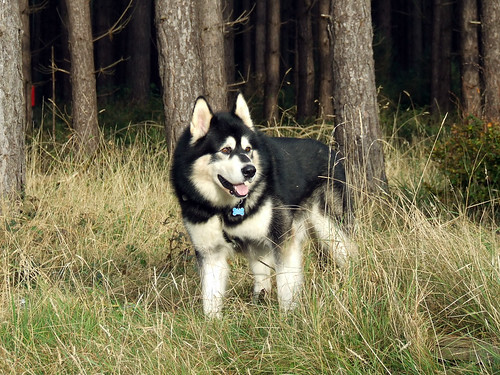Alaskan Malamute
History of the breed
The Alaskan Malamute is a large dog originally bred for use as an Alaskan sled dog and is often mistaken for a Siberian Husky. According to the AKC, the primary criterion for judging the Malamute in a show is its function to pull heavy freight as a sled dog; everything else is secondary. As many an owner has found out, the pulling power of a Malamute is tremendous. While a few Malamutes are still in use as sled dogs for personal travel, hauling freight, or helping move heavy objects, some are used for the recreational pursuit of sledding also known as mushing, also skijoring, bikejoring, and canicross. However, most Malamutes today are kept as family pets or show dogs.
Appearance of the breed
The AKC breed standard calls for a natural range of size, with a desired freighting weight of 75 to 85 pounds and a height of 23 to 25 inches. Heavier individuals (90lbs) and dogs smaller than 75 pounds are common. There is often a marked size difference between males and females. The coat is a dense double northern dog coat, somewhat harsher than that of the Siberian Husky. The usual colors are various shades of grey and white, sable and white, black and white, red and white, or pure white. Eyes are almond-shaped and are always brown; blue eyes are an indication of mixed breeding and will disqualify the dog in shows. The physical build of the Malamute is compact with heavy bone. In this context 'compact' means that their height to length ratio is slightly longer than tall, unlike dogs like Great Danes which are longer and lankier in their ratios. The malamute has a plume like tail that is well furred and hangs just over the back like a "plume". Corkscrew tails can now be seen but is not the breed description . A corkscrew tail is what you would see in the Akita. The malamutes' tails, well-furred, aid in keeping them warm when they curl up in the snow . They wrap the tail around their nose and face which helps protect them against harsh weather like blowing snow.
Characteristics of the breed
Alaskan malamutes are unsuited for hot climates. When the weather gets hot, like any other breed of dog, the malamute needs plenty of water and shade. They will grow a winter coat and subsequently, come spring, shed it again. The Malamute has an affectionate nature does not make them useful as watch or guard dogs. If a dog owner cannot cope with a dog that will not comply with the owner's every command, a more compliant breed should be selected. Malamutes are, as a general rule, particularly amiable around humans and children and in some instances friendly with smaller dogs, it is probably a good rule of thumb to be mindful of your Malamute around smaller animals until you have become acquainted with its behavior.
Overall Malamutes are quite fond of people, a well known trait that makes them particularly sought-after family dogs. Malamutes are thought to be clumsy, but are nimble around furniture and smaller items, making them ideal house dogs. However, they prefer to be outdoors in winter to enjoy the snow. If they are year-round outdoor dogs, letting them play in a baby pool filled with cold water in summer keeps them cool. They will stand in the baby pool at times, seemingly doing nothing at all. However, they absorb much of the coolness of the water through their paws.
The majority of Malamutes are also fairly quiet dogs, seldom barking like most other dog breeds. When it does vocalize, more often than not they tend to "talk" by vocalizing a "woo woo" sound. They may howl like wolves or coyotes, and for the same reasons. When they howl, the howl is difficult, if not impossible, to distinguish from the wolf.
Health Concerns of the breed
Health issues in Malamutes include:
>inherited polyneuropathy
>chondrodysplasia,
>cataract
>progressive retinal atrophy








